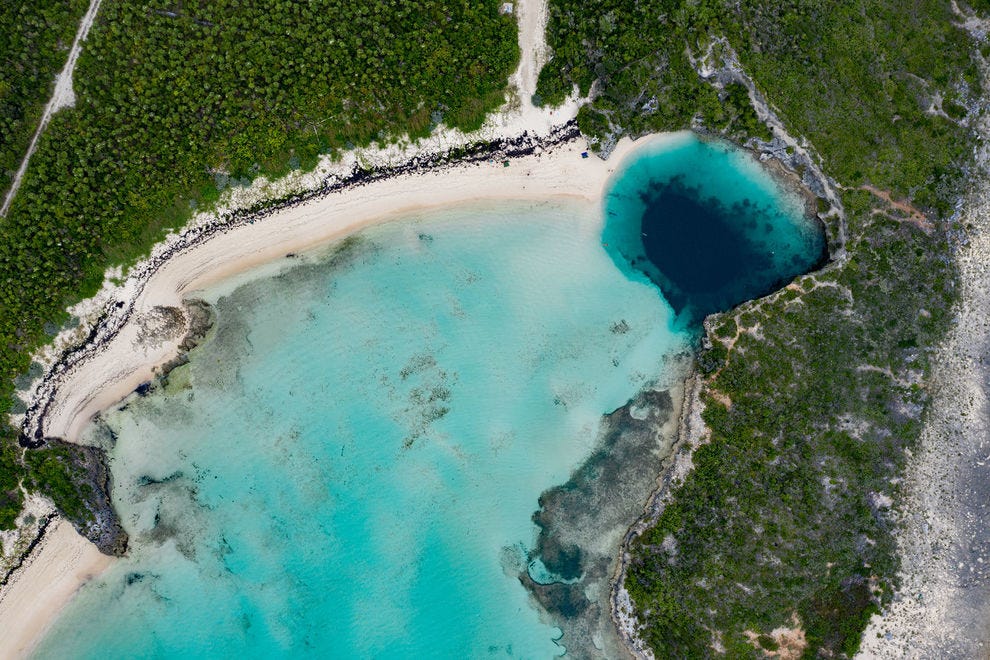 Photo courtesy of iStock / JoseIgnacioSoto
Photo courtesy of iStock / JoseIgnacioSoto
Sinkholes are found around the world
Sometimes, what looks like solid ground suddenly collapses to create some of the world’s most spectacular natural sights: sinkholes, blue holes and cenotes. These fascinating natural phenomena are both beautiful and dangerous.
 Photo courtesy of E+ / Mlenny
Photo courtesy of E+ / Mlenny
Great Blue Hole | Belize
The nearly perfect circular sinkhole known as the Great Blue Hole has become one of the world’s top dive sites. The 1,043-foot-wide hole came to be after an above-ground cave collapsed some 15,000 years ago. Today, it’s a UNESCO World Heritage site and a great spot for beginner divers.
 Photo courtesy of iStock / Dreamframer
Photo courtesy of iStock / Dreamframer
Blue Holes | Palau
Found next to the beautiful Blue Corner in Palau, Blue Holes is a large, deep cavern beloved by adventurous divers. There are four holes in the reef that enter the cavern, which is home to wire corals, sea fans and leopard sharks.
Photo courtesy of iStock / gappino
Ik Kil | Yucatan, Mexico
The Mexican Caribbean is known for its cenotes and aquatic caves, and the Ik Kil cenote is perhaps the most beautiful of them all. Vines drape from the ledge of the 200-foot-wide opening above, and a staircase leads visitors down to the edge of the water, where you can swim with the black catfish that call the pool home.
You’ll find this amazing sinkhole 2 hours west of Cancun.
 Photo courtesy of iStock / EdoTealdi
Photo courtesy of iStock / EdoTealdi
Darvaza Crater | Turkmenistan
Turkmenistan’s Darvaza Crater, known as the ‘door to Hell,’ isn’t a natural sinkhole. It’s reputed to have formed when Soviet scientists were drilling into the natural gas fields of the area. The ground gave way, and the entire rig and drilling camp were swallowed.
When the researchers noticed methane gas leaking from the gaping hole, they lit it on fire in 1971 to try to avoid any potential dangers to the environment and nearby population. It’s been burning continuously ever since.
 Photo courtesy of iStock / Keith Molloy
Photo courtesy of iStock / Keith Molloy
Bimmah Sinkhole | Oman
Oman’s Bimmah Sinkhole is considered one of the most beautiful on the planet, and it serves as a swimming hole for local residents and tourists who come to see its azure waters.
This particular sinkhole was formed over time as groundwater gradually wore away at the limestone until it collapsed to create this beautiful and dramatic scene.
 Photo courtesy of iStock / Enrico Pescantini
Photo courtesy of iStock / Enrico Pescantini
Dean’s Blue Hole | The Bahamas
Dean’s Blue Hole in the Bahamas is the world’s second deepest known saltwater sinkhole, plunging 663 feet into the bay off Long Island. It’s also the site of many freediving stunts.
 Photo courtesy of iStock / Dreamframer
Photo courtesy of iStock / Dreamframer
Montezuma Well | Arizona
Located in Arizona’s Montezuma Castle National Monument, Montezuma Well was formed by the collapse of a limestone cave. Today, more than a million gallons of water flow through the sinkhole each day.
The landmark’s most fascinating feature is its unique ecosystem created by highly carbonated water with high levels of arsenic – a comfortable home for five endemic species found nowhere else in the world.
 Photo courtesy of iStock / Tomasz Dutkiewicz
Photo courtesy of iStock / Tomasz Dutkiewicz
Blue Hole of Dahab | Egypt
Located just north of the city of Dahab, Egypt on the coast of Sinai Peninsula is the Blue Hole. Known as an ‘underwater cathedral,’ this sinkhole is 394 feet deep and is lined by gorgeous coral. Dangerously deep and disorienting, several experienced divers have tested their limits here – and lost.
 Photo courtesy of iStock / mvaligursky
Photo courtesy of iStock / mvaligursky
Nanda Blue Hole | Vanuatu
Nanda Blue Hole, also known as Jackie’s Blue Hole, is one of several blue holes in Vanuatu. Appearing as a perfect, secluded lagoon oasis in the jungle, this blue hole is reachable via a 2-hour paddle up a tidal river during an incoming high tide. It’s also capable of being reached by car, and visitors receive a free warm drink with entry.
